Inside Rotterdam’s quest to green 10 million square feet of rooftops
There’s a saying in Dutch, “Je kan het dak op,” which, translated literally, means “you can go up on the roof.” But what it really means is “get lost.”
The origins of the saying are difficult to trace, but for Paul van Roosmalen, it probably has to do with the fact that no one thinks of a flat, grey roof as somewhere you want to be. Van Roosmalen works in the Department of Sustainability for the municipality of Rotterdam, where he leads a program called Multifunctional Rooftops. And, in many ways, his job is to change that preconception.
If you think of a traditional Dutch house, you probably picture a gabled roof, but Rotterdam is different. Much of the city center was razed during World War II, leaving behind a flattened landscape rife for reinvention. Today, Rotterdam has over 650,000 inhabitants and more than 150 million square feet of flat roofs. Most of them are unused, but in the past few years, this has been changing.
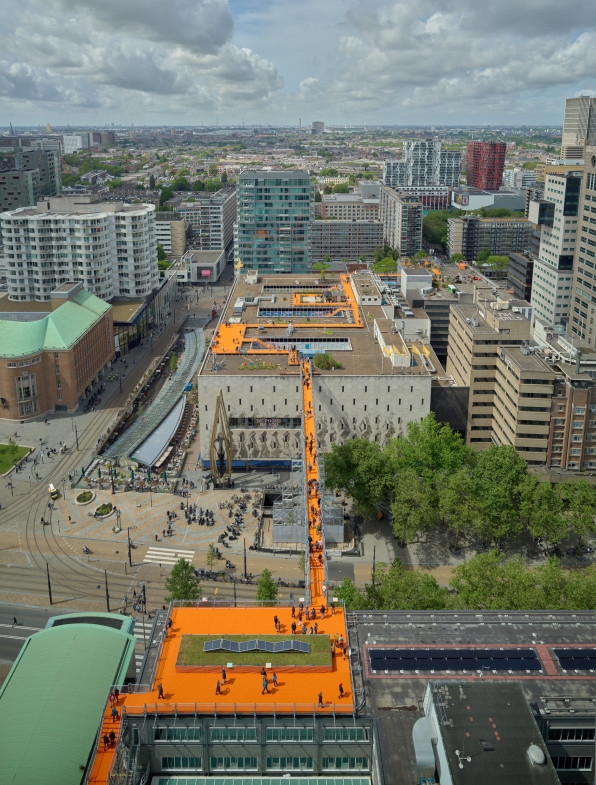
This weekend, Rotterdam is opening 20 of its rooftops to the public. Think of it like an open house, but for roofs. Known as the Rotterdam Rooftop Days, the festival aims to highlight the untapped potential of rooftops by organizing an extensive program of tours, concerts, exhibitions, and dinners.
This year, the festival is anchored by two striking rooftop installations, both of them co-designed by local starchitects MVRDV and Rotterdam Rooftop Days. They’re only temporary–one will come down at the end of June, the other in the middle of August—but they’re part of a flourishing network of green rooftops that are helping the city combat the urban heat island effect, absorb rainwater during storms, reduce air pollution, and increase biodiversity.
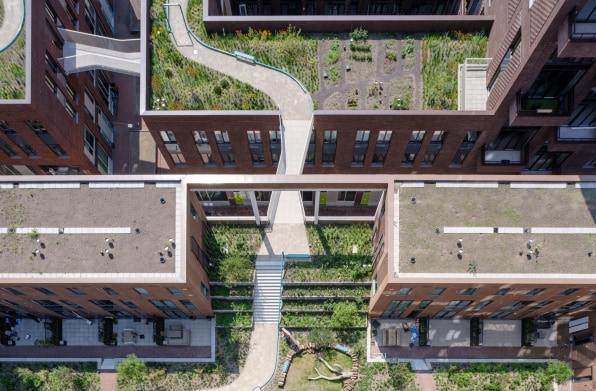
From green roofs to multifunctional machines
It all started in 2008, when Rotterdam became the first of three municipalities in The Netherlands to provide a subsidy for green roofs (the other two being Amsterdam and Groningen). Then the program managers realized they could do more than simply greening roofs. About 90% of Rotterdam is below sea level, so the city has become something of a laboratory for clever water management: sponge parks absorbing water, sunken squares doubling as water retention ponds, and parks designed to flood. Except the city doesn’t have enough space for bigger interventions and large water retention ponds. So, what about roofs? “If you can do this on a lot of rooftops, you have a lot of small-scale solutions and that would add up to this one big-scale solution,” says Van Roosmalen.
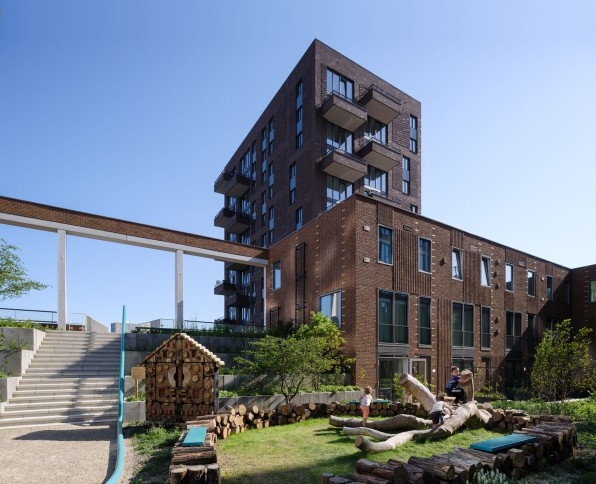
Thus came “blue roofs” (to capture water) and “yellow roofs” (to harness solar and wind energy), and in 2019, the multifunctional rooftop program was formally integrated into the Department of Sustainability. By the end of 2021, 4.9 million square feet of green roofs could retain a total of 10 million liters of water (enough to fill four Olympic swimming pools). Of those roofs, 4.6 million square feet were also covered by solar panels (enough to power 26,800 homes).
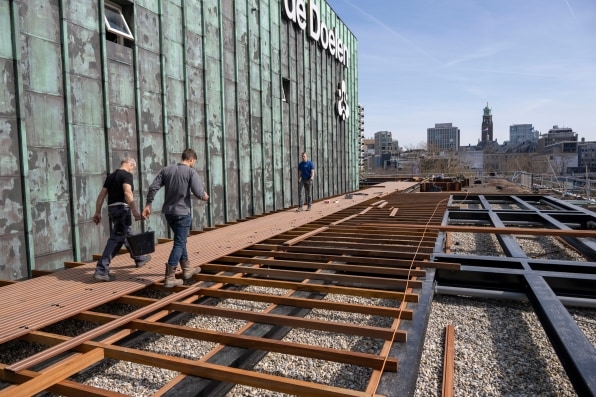
De Doelen, a brutalist 1960s concert hall in the heart of the city, was renovated in 2009, and now a roof upgrade is almost complete. Courtesy of Kraaijvanger Architects, the roof features a central pathway that people can walk on, with water tanks hidden below that can hold 2,000 bathtubs worth of rainwater. Scheduled to open next month, the rooftop upgrade cost just under $1.1 million, with funding from a European program called Life@UrbanRoofs. (Several other rooftops in the city have been greened with the same program, including The Peperklip, a social housing complex with the longest green roof in The Netherlands.)
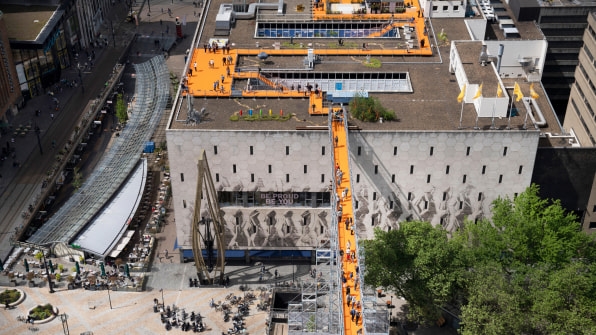
The fight for public access
Unlike the festival’s rooftop installations, however, the roof of De Doelen is only accessible to employees and concertgoers. In this case, public access is a challenge, because the building is landmarked, but the problem extends to non-landmarked buildings as well. In De Groene Kaap, a five-building residential complex that opened in 2021, a central courtyard turns into a terraced rooftop garden with bridges stretching between buildings. The rooftop was meant to be public, but the homeowners association is now pushing back because that would require hiring staff to maintain the park and keep it safe. When I visited last month, Léon van Geest, who leads the Rotterdam Rooftop Days festival, had to unlock a gargantuan, automated gate to let us into what has become a gated community—at least for now.
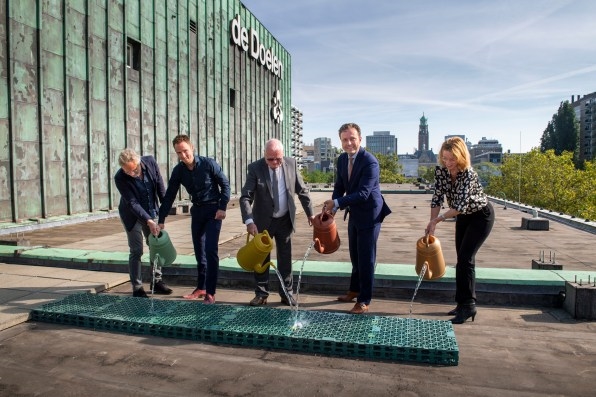
In a way, accessibility doesn’t necessarily matter, at least not for the roofs to perform sustainably. A green roof can help increase biodiversity, retain and store water, and provide energy to the building without anyone ever setting foot up there. But for building owners who want to use the rooftop to generate revenue, the city is encouraging various other functions like rooftop bars and restaurants. “One way or another we’re still stuck in ROI thinking and eternal economic growth,” says Van Roosmalen. “A rooftop bar can make a lot of money and nobody wants to sit on a [grey] rooftop, you want to sit in a green environment.”
For Van Roosmalen, the most logical time to design a roof is during a large-scale renovation when the roof needs replacing, or better yet, before the building is even built. But here too, challenges abound. Green roofs aren’t mandated in the national building code, which makes it impossible for the municipality to impose them on new buildings or even retrofits. This is compounded by the fact that most buildings in the city are privately owned. “We don’t own stuff, and we can’t say you should [build a green roof],” says Van Roosmalen.
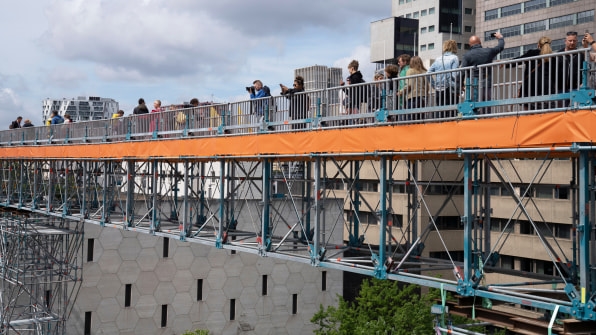
Looking to the future
What the city can do, however, is offer subsidies: Qualifying roofs must be able to retain 30 ml of water per square meter. In return, building owners can get up to $530 for every cubic meter of water collected through the green roof. To further encourage building owners to retrofit their roofs–and help them understand the hidden potential—the city has also built an interactive online map tool. Anyone can go on the website, plug in a ZIP code, and see if their roof is fit for an upgrade. You can learn about the load-bearing capacity of the roof, choose between solar and various levels of greening, and see how big a subsidy you would get for the size of your roof. (To green a 750-square roof, for example, the tool estimates it will cost about $4,500, with a municipal subsidy of $1,900.)
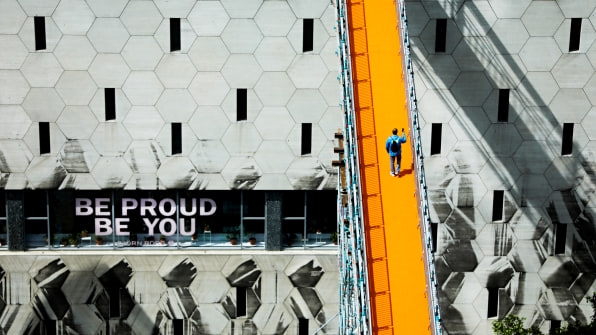
These tools are helpful, but they only work if building owners, developers, and citizens alike understand the benefits of upgrading their roofs—and are interested in making a change. Van Roosmalen recalls a time when the money was raised, the permits were in place, and the design proposal for a roof was done, “but the owner didn’t care,” he says.
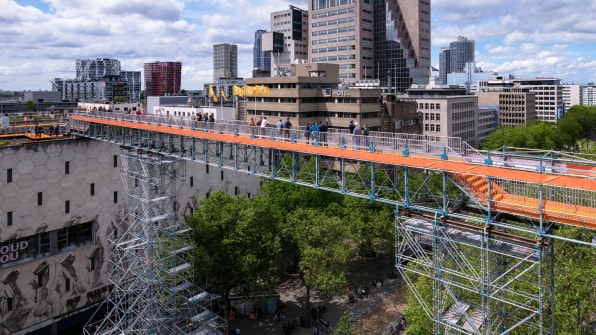
This is where Rooftop Days come into play. All next month, the people of Rotterdam can walk up an imposing neon-pink stair and get up to the roof of the Het Nieuwe Instituut museum, which isn’t typically open to the public. Across town, they can ascend a winding bright-orange stair, walk over an air bridge high above a road, and end up on the roof of a department store in the city center. “You need a place where people can go, see, smell, hear, experience it,” says Van Roosmalen.
Ultimately, the city’s goal is to convert over 10 million square feet of flat roofs into multifunctional roofs with greenery, water retention systems, and solar panels. It’s a slow journey and it may take 25 years, but by the end, maybe that Dutch saying will have lost its meaning–and rooftops will be a place people actually want to be.
(31)


